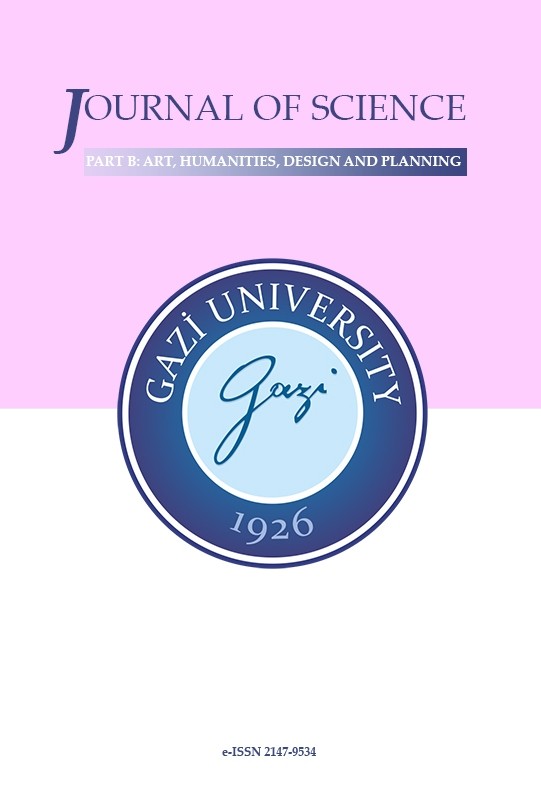Evolution of Brick Architecture Through Digital Tools and Technologies
Evolution of Brick Architecture Through Digital Tools and Technologies
___
- [1] Oxman, R., Informed tectonics in material-based design. Design Studies, 2012. 33(5): p. 427-455.
- [2] Iwamoto, L., Digital fabrications: architectural and material techniques. 2013: Princeton Architectural Press. p. 4-5
- [3] Kolarevic, B. and K. Klinger, Manufacturing material effects: rethinking design and making in architecture. 2013: Routledge. p. 6-24
- [4] Pottmann, H., Architectural geometry and fabrication-aware design. Nexus Network Journal, 2013. 15(2): p. 195-208.
- [5] Grobman, Y.J., Cellular building envelopes, in ICoRD'13. 2013, Springer. p. 951-963.
- [6] Garritzmann, U. Tectonic Expressions in Brick Architecture. in CA2RE: Conference for Artistic and Architectural (Doctoral) Research. 2018. Arkitektskolen Aarhus.
- [7] Collier, C.J., CODE to MATTER - Integrating Industrial Robotic Arms: Reconciling the Rapid Advancement of Digital Potentials with a Tangible Physical Existence. 2016, University of Washington: Ann Arbor. p. 40.
- [8] Flöry, S. and H. Pottmann, Ruled surfaces for rationalization and design in architecture. 2010.
- [9] Kroger, S.A., Architecture Built to Last: The Timelessness of Brick. (Doctor of Philosophy), 2005, University of Cincinnati.
- [10] Lynch, G., S. Roundtree, and S. Architects, Bricks‐A guide to the repair of historic brickwork. Government Publications Sales Office, Dublin, Ireland, 2009. p. 5-6.
- [11] Shahzada, K., et al., Sustainable Buildings in District Dera Ismail Khan and Adjoining Areas: An Experimental Study. 2009. p. 142
- [12] Lyons, A., Materials for architects and builders. 2014: Routledge. p. 1.
- [13] Little, T.S., Materials Matter: Exploring Unconventional Appliications of Brick in Architecture. (Master’s Thesis), 2006, University of Cincinnati.
- [14] Peters, B., Building bytes: 3D-printed bricks. in Proceedings of the 33rd Annual Conference of the Association for Computer Aided Design in Architecture (ACADIA). 2013. p. 433-434.
- [15] Dalkılıç, N. and A. Nabikoğlu, Traditional manufacturing of clay brick used in the historical buildings of Diyarbakir (Turkey). Frontiers of Architectural Research, 2017. 6(3): p. 346-359.
- [16] Brick Industry Association, Manufacturing of brick. Technical notes on brick construction, 2006. 9: p. 1-7.
- [17] URL-1. Retrieved from http://www.co2olbricks.de/index.php?id=178, Last Accessed: 25.09.2021
- [18] Kline, E., Ceramic Architecture: Showcasing a Forgotten Architectural Medium Through Recycled Rubble. (Master of Thesis), 2017, University of Cincinnati.
- [19] Murphy, E., [De] constructing Guastavino Vaulting. 2020, Columbia University.
- [20] URL-2. Retrieved from https://brickarchitecture.com/about-brick/brick-news/muuratsalo-experimental-house-by-alvar-aalto Access Date: 27.09.2021
- [21] URL-3. Retrieved from https://www.domusweb.it/en/from-the-archive/2012/09/08/louis-kahn-in-dacca.html, Last Accessed: 27.09.2021
- [22] Fiala, J., M. Mikolas, and K. Krejsova. Full Brick, History and Future. in IOP Conference Series: Earth and Environmental Science Sci. 221 012139. 2019: IOP Publishing.
- [23] Andreani, S. and M. Bechthold, R] evolving brick: geometry and performance innovation in ceramic building systems through design robotics. Fabricate 2014 Proceedings, 2014.
- [24] Al-Haddad, T., et al. Representation+ Fabrication: Connecting descriptions and artifacts in the digital age. in 1st International Conference on Structures and Architecture (ICSA), University of Minho, Guimarães, Portugal. 2010.
- [25] Sarıdal, C., A Research on Architectural Design Techniques and Manufacturing Processes in the Digital Age. (Doctor of Philosophy), 2007, Istanbul Technical University.
- [26] Lipton, J.I., D. Cohen, and H. Lipson, Brick Printing: Freeform Fabrication of Modular Architectual Elements with Embedded Systems. in International Solid Freeform Fabrication Symposium, Texas. 2009.
- [27] Bechthold, M. Surface Structures: digital design and fabrication. in Proceedings of the ACADIA Conference. 2004.
- [28] Oliveira, R. and J.P. Sousa, Building Traditions with Digital Research Reviewing the Brick Architecture of Raúl Hestnes Ferreira through Robotic Fabrication. in Proceedings of the 34th eCAADe Conference, 2016. pp. 123-131.
- [29] Imbern, M. A Digital Approach to Ceramic Structural Surfaces. in Proceedings of the 32nd Annual Conference of the Association for Computer Aided Design in Architecture (ACADIA), San Francisco. 2012. p. 315-321
- [30] Paşaoğlu, T.A., Mimarlık ve Strüktür. (Doctor of Philosophy), 2016, Istanbul Technical University.
- [31] Kazemi, M. and B. Borjian, Algorithmic Approach Functions in Digital Architecture and its Effect on Architectural Design Process. in European Online Journal of Natural and Social Sciences: Proceedings, 2015. 4(3 (s)): p. pp. 508-516.
- [32] Caetano, I., DrAFT: an algorithmic framework for facade design. in Proceedings of the 34th eCAADe Conference, Finland. 2016. p. 465-474
- [33] Oxman, R. and R. Oxman, New structuralism: design, engineering and architectural technologies. Architectural Design, 2010. 4(80): p. 14-23.
- [34] URL-4. Retrieved from https://www.archdaily.com/260612/winery-gantenbein-gramazio-kohler-bearth-deplazes-architekten, Last Accessed: 18.09.2021
- [35] URL-5. Retrieved from https://divisare.com/projects/260919-gramazio-kohler-ralph-feiner-gantenbeinvineyard-facade, Last Accessed: 30.09.2021
- [36] Bonwetsch, T., F. Gramazio, and M. Kohler. Digitally fabricating non-standardised brick walls. in ManuBuild, 1st International Conference, Rotterdam. 2007.
- [37] López, D., M. Domenech, and M. Palumbo, “Brick-Topia”, The Thin-Tile Vaulted Pavilion. journal of Case Studies in Structural Engineering, 2014. 2. p. 33-40.
- [38] López, D., M. Domenech, and M. Palumbo, Using a construction technique to understand it: thin-tile vaulting. in A: International Conference on Structural Analysis of Historical Construction. "SAHC2014 - 9th International Conference on Structural Analysis of Historical Constructions". Minho: Universidade do Minho, 2014, p. 1-9.
- [39] URL-6. Retrieved from https://www.archdaily.com/964980/clay-rotunda-gramazio-kohler-research, Last Accessed: 19.09.2021
- [40] Willmann, J., et al., Aerial robotic construction towards a new field of architectural research. International journal of architectural computing, 2012. 10(3): p. 439-459.
- [41] Lange, C. and D. Holohan, CeramicINformation Pavilion-Rethinking structural brick specials through an indexical 3D printing method. in Proceedings of the 24th CAADRIA Conference, New Zealand, 2019. p. 103-112.
- Yayın Aralığı: Yılda 4 Sayı
- Başlangıç: 2013
- Yayıncı: Gazi Üniversitesi
Önder TOSUN, Hasan EFE, İhsan KÜRELİ
Evolution of Brick Architecture Through Digital Tools and Technologies
Mutual Relationship of Culture and Architecture: Focused on Residential houses in Kabul City
Ahmad Walid AYOOBİ, Mehmet İNCEOGLU
Özlem SAĞIROĞLU DEMİRCİ, Muharrem ŞANVER
ASPECT OF CONSUMER BEHAVIOURAL THEORY IN THE CONTEXT OF GRAPHIC DESIGN
Virtual Reality in Product Design: Researches between 1997 and 2021
